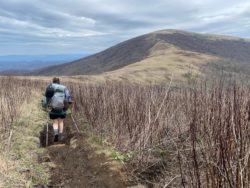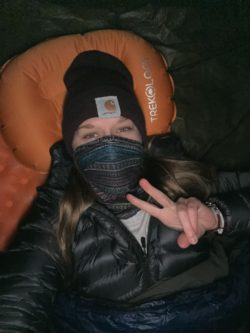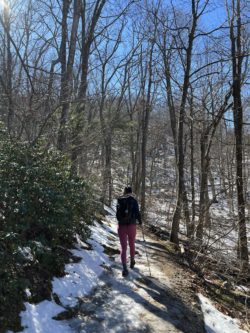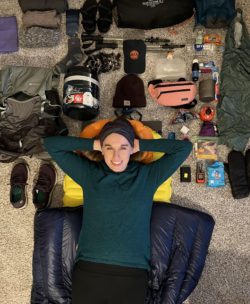
Seeing What Works for Me: AT 2023 Gear List – The Trek
Gear. With the start of thru hiking season quickly approaching, gear is consistently one of the biggest topics on an aspiring thru hikers mind. “Is this going to be comfortable? Is there something more lightweight? Should I add this? What should I ditch?” are all questions circling our minds. Which makes sense; we’ll be relying on it to help get us to our final destination for six months. It’s impossible to log onto the AT Class of 2023 Facebook page and not rethink my own gear choices. (I think) I’ve nailed down my gear set up for my March start date, knowing that I’ll likely decide to swap things in my kit out once I get more miles under my (hip)belt. And you know what, that’s okay. I’m not going to stress about it. I’m going to start with what I have and adjust from there. For all my gear, I decided to wait for sales to spend more money on the larger pieces of my gear kit, while saving a few dollars on some smaller pieces.
Big Three
Tent: REI Quarter Dome SL 2
I like this semi-freestanding tent because it’s easy to set up with a color-coded pole and grommet system. Is is the lightest tent on the market? No, but it doesn’t take a lot of technique to be successful and has a good weight/price/ease of setup ratio. For a footprint, I’m using a sheet of polycryo.
Backpack: Gossamer Gear Mariposa 60
I chose this pack for one main reason: pockets. This pack has several pockets and zippers to help keep my things organized. I love that the hipbelt pockets are big enough to fit my phone. I’ve also added shock cord to the loops on the outside mesh so I can hang clothes to dry and my camp shoes, as well as a Bottle Rocket. The water bottle holder is honestly one of my favorite parts of my pack, making my water super accessible. A pack liner ensures everything in my pack stays dry.
While it wasn’t on my original packing list, I am going to bring a fanny pack, as it seems like it will be super convenient to have when I’m in town resupplying. This isn’t a special backpacking belt bag, it’s just one that I already had with a waterproof liner that I originally got for kayaking excursions.
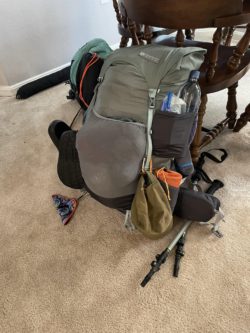
The night before I left for my first section hike. I’ve learned a lot since then about about trimming down my gear list and how to better pack my backpack.
Sleep System: Thermarest Neoair Xlite and Enlightened Equipment Enigma Quilt
As a stomach and side sleeper, an inflatable sleeping pad was a must for me. I recently switched out my sleeping pad from a Sea to Summit pad to the Thermarest that everyone seems to carry. This one has a higher r-value and saves a few ounces. I bought it from REI, so if I decide I can’t stand the sound of sleeping on a bag of chips any longer, I can utilize their return policy, and have my family send me my trusty Sea to Summit. I also plan on bringing a 1/8 inch foam pad to help protect the Thermarest, make it less noisy, and add a tiny bit of warmth.
For a sleeping bag, I decided to go with an Enlightened Equipment Enigma 0 degree down quilt. As I mentioned that I am a stomach/side sleeper, the thought of being constricted in a mummy bag all night brought out a claustrophobia I didn’t know I had. I’m glad to have a polyester sleeping bag liner to keep my quilt cleaner as well as add some warmth. This isn’t the must luxurious bag liner on the market, but it’s what I have so I’m going to start with it, and can always pick up a warmer one if needed. My pilow also isn’t the fanciest brand on the market, but I think it’ll get by just fine. The final piece of gear in my sleep system is one of my “luxury” items- a cheap eye mask to cover my eyes when sleeping. While I don’t typically use this in “normal” life, I find that I fall asleep so much faster on trail when my eyes aren’t allowed to stare at the top of my tent.
Clothing
Hiking Clothes
- Topo Trail Runners I love hiking in trail runners, but Altras just weren’t for me. I love Topo’s because they have a wide toe-box, and have a low heel-drop, but aren’t zero-drop. This isn’t their newest model of the Ultraventures, but it’s what feels best for me. I’ve also added in a pair of insoles. This isn’t a popular brand, but I’ve been wearing them in my running, and now hiking shoes, since I was 16 years old. My sports medicine doctor recommended them based on my feet and gait, and they seem to work for me.
- REI Down Puffy Jacket Puffy jacket with a hood was a must
- Appalachian Gear Company Alpaca Hoodie
- Thrifted synthetic Under Armour t-shirt
- Nike running shorts (found on the clearance rack at Kohl’s). Specifically, I like that they have pockets
- REI Leggings These leggings fulfill my two most important features: a drawstring and pockets. After wearing the same leggings day in and day out, there is nothing worse than having to hike them up with every step on the trail. A drawstring will help keep me sane, and pockets are just convenient.
- Socks: I’m giving two different systems a try: Darn Toughs with Injinji liners paired with them, and thicker Injinji socks to be worn on their own.
- Sports bra: Something comfortable I’ve already had for years from Aerie
- Underwear: 2 pairs of different brands, both merino wool
Sleeping Clothes and Accessories
- Sleep shirt: Polyester Joy Lab long sleeve shirt I got on sale at Target
- Sleep pants: Rayon/polyester blend baggy pants I thrifted. They are lightweight and SO cozy. I know most people opt for merino wool sleep sets, but after hiking in leggings all day long, I like to sleep in something more comfortable and loose
- Sleeping socks: REI wool socks
- Buff to wear as a headband, and also good to keep my face warm when I sleep
- Ball cap that I got at an event with my dad
- Carhartt beanie- tryin’ to be a cool kid
- Torrid mittens and waterproof shells – Down mittens might seem like overkill, but I have Raynaud’s Syndrome, so keeping my hands warm is crucial for my on trail sanity. I’ve found mittens work better for me than gloves because your fingers stay touching, and the GORE-TEX shell will keep them dry.
- Camp shoes: Thrifted (and sanitized) Xero shoes
- Rain gear: Going with a classic, the oh-so-fashionable Frogg Toggs. I also like to carry a cheap plastic poncho to ensure my pack stays dry when it rains.
- Sunglasses: Cheap pair because I know they’re going to get broken, but eye protection is important!
Food/Water
- Stove: MSR Pocket Rocket
- Cook pot: Toaks 750mL Titanium food pot
- Utensil: Toaks Titanium spork
- Lighter
- BearVault BV475 -I know all the thru hikers are shaking their heads at this one. I know it’s not necessary on the AT. But here’s the thing: I hate hanging a bear bag. I hate throwing the line and taking it back down in the morning. The cord tangling up drives me crazy. It’s just a hassle. Since it’s a pain in the butt, a lot of hikers end up ditching the system all together and sleep with their food. Carrying the BV475 makes the start of my hike simple by stowing it away easily. I’ve added some stickers, reflective tape, and an Airtag to make it easy to track down in the morning. I was a little worried that it might be hard to open when I’m cold, but I learned a trick to open it with an old giftcard, and the lid unscrews super smoothly
- Water filtration: Sawyer Squeeze with Evernew bag for water collection. I know a lot of hikers like to screw their Sawyer onto a Smartwater bottle and drink directly from the filter, but I like collecting water in the bag and squeezing it into the bottle so I have clean bottles to add electrolyte packs to.
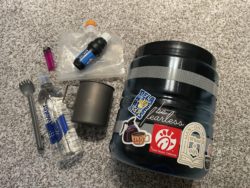
Hygiene
- Mini toothpaste, floss, and collapsible toothbrush
- Baby wipes
- Kula Cloth -When I first heard about this alternative to TP, I never thought I would use one. But after learning about the antimicrobial materials, it really doesn’t bother me on trail
- Trowel: The Deuce of Spades UL
- DivaCup – I’ve been using this for years, but I’m still not sold on using it on trail. Will bring some tampons as a backup
- Mini Wet Brush -Mainly for town stops. My long, straight hair gets tangled if I don’t brush it after showering
- Sunscreen: Even with the coverage of “The Green Tunnel,” I’m still wearing sunscreen. I sizzle like bacon the moment I step out in the sun
- Chapstick
- Cork ball to help roll out my feet and muscles
- First aid kit: Leukotape, Bandaids, Immodium, sewing needle, earplugs, nail clippers, alcohol pads, individual packs of antibiotic ointment, ibuprofen, and turmeric as a natural anti-inflammatory
- Hand sanitizer
Miscellaneous
- Dry bag to ensure my sleep clothes stay dry
- Satellite phone: Garmin inReach Mini to check in at home if I don’t have cell service
- Trekking poles -Such a game changer when it comes to hiking to give your help distribute your weight and provide some more stability. I am going to replace the tips before I hit the trail
- Microspikes -Needed for a March start? Probably not. But again, it gives this clumsy hiker some peace of mind, especially after hitting some icy stretches around the Roan Highlands last year. They’ll be the first thing to be sent home once warmer weather rolls in.
- Various charging cords, wall charger with 3 ports, earbuds, and an Anker charging block
- Microfiber towel to use as a sweat rag and to dry off my tent
- Headlamp: Black Diamond Spot that I “borrowed” from my brother 2 years ago
- Repair kit: Sleeping pad patch kit, strips of duct tape, extra hair ties
- Handwarmers- Again, Raynaud’s
So, that’s what’s going with me to Georgia. I’m excited to see what makes it all the way to Maine!
This website contains affiliate links, which means The Trek may receive a percentage of any product or service you purchase using the links in the articles or advertisements. The buyer pays the same price as they would otherwise, and your purchase helps to support The Trek’s ongoing goal to serve you quality backpacking advice and information. Thanks for your support!
To learn more, please visit the About This Site page.
